South Africa 1982 "Karoo Fossils"
| <prev | back to index | next> |
| Issue Date | 01.12.1982 |
| ID | Michel: 622-625, Bl. 14; Scott: 606-609, 609a; Stanley Gibbons: 532-535, 536; Yvert et Tellier: 527-530, 14; Category: pR |
| Design | Sheila Nowers |
| Stamps in set | 4 |
| Value | 8c - Bradysaurus 15c - Lystrosaurus 20c - Euparkeria 25c - Thrinaxodon< |
| Size (width x height) | stamps: 31 mm x 24mm, Mini-Sheet: 106 mm x 95 mm. |
| Layout | Sheets of 25 stamps each, Mini-Sheet of 4. |
| Products | FDC x2, MS x1 |
| Paper | Harrison, phosphorus coated, PVA gum |
| Perforation | 14.0 x 14.50 |
| Print Technique | Offset lithography |
| Printed by | Government Printer, Pretoria |
| Quantity | 25.000.000, 2.500.000, 3.250.0000, 3.000.000 |
| Issuing Authority | South African Postal Administration |
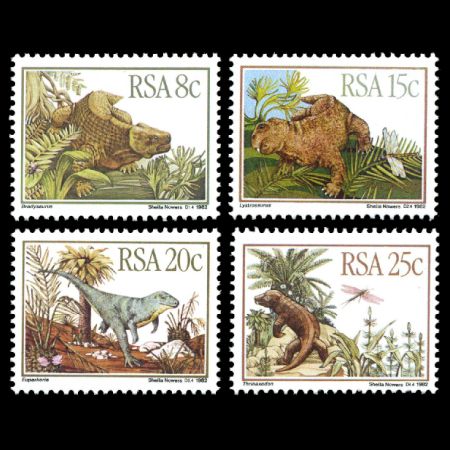
On December 1st, 1982, the Post Authority of South Africa issued the set of four stamps "Karoo Fossils".
The rocks of the Karoo Sequence cover approximately half of the surface of the Republic of South Africa. These rocks contain one of the most complete records of the evolution of land animals during the Permian and Triassic Periods about 250 to 150 million years ago. These fossils occur in great abundance and have drawn the attention of scientists from all over the world, including Sir Richard Owen who was receiving them from father and son Bain (Andrew Geddes Bain (1797-1864) and Thomas Charles John Bain (1830-1893)).
 |
| Bradysaurus on stamp of South Africa 1982, MiNr.: 622, Scott: 606. |
 |
| Lystrosaurus on stamp of South Africa 1982, MiNr.: 623, Scott: 607. |
This large, sluggish stem reptile lived approximately 250 million years ago. it grew to about 5 m in length and must have been very clumsy because of its large body and short, thick legs and feet. Its almost hand-shaped teeth had small cusps on the edges and the specimens found are sharp and unworn. It is therefore thought that the animal fed on soft, floating water plants.
Lystrosaurus
Lystrosaurus lived about 220 million years ago in Africa, India, Antarctica, Russia and China, which indicates that the Southern continents were once part of a super continent named Gondwanaland. The animal's eyes, and nostrils were placed high up in the head so that it could protrude only the top of its head above the water like a hippopotamus. It was probably herbivorous.
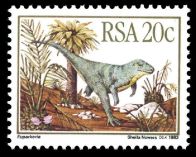 |
| Euparkeria on stamp of South Africa 1982, MiNr.: 624, Scott: 608. |
 |
| Thrinaxodon on stamp of South Africa 1982, MiNr.: 625, Scott: 609. |
This small bipedal reptile was a slender, agile and active animal that was undoubtedly carnivorous. It lived about 200 million years ago. It is generally accepted that Euparkeria was ancestral to the dinosaurs that were to become the dominant terrestrial animals of later geological periods until this position was taken over by the mammals.
Thrinaxodon
Thrinaxodon was a small mongoose-like reptile that lived about 220 million years ago. Many scientists think that it could be ancestral to the mammals. Some palaeontologists think that the animal could have been warm-blooded and could have had hair like a mammal. It was carnivorous.
Products
| FDC | Mini-Sheet | |
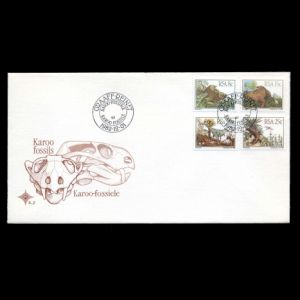 |
 |
 |
|
Commemorative envelope: Emydops Emydops was a rabbit-sized reptile with a long body and short, stumpy legs. It was herbivorous, with large tusks and small back teeth. The tips of the jaws were covered in horn as is the case in tortoises. It lived about 250 million years ago. |
Commemorative cover with
miniature sheet: Heterodontosaurus This small, primitive dinosaurus lived about 150 million years ago. It grew to a length of about 1,5 m and was herbivorous. Unlike other dinosaurs it had canine-like teeth near the front of its jaws. The back teeth were adapted to a vegetarian diet. |
|
| FDC | ||
 |
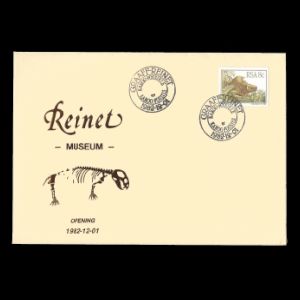 |
|
| The FDC of the Reinet Museum from Graaf-Reinet | ||
| Example of Circulated Covers | ||
 |
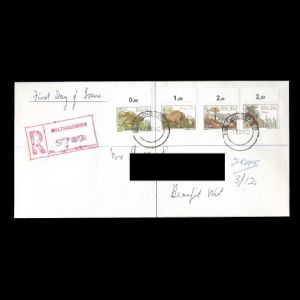 |
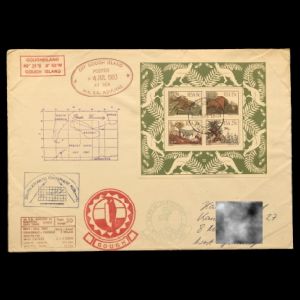 |

|
References
- Technical details and short description:
Inside text of FDC, Bulletin. - Karoo:
Wikipedia - Reinet Museum:
official homepage Daily Maverick
| <prev | back to index | next> |